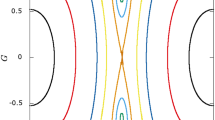Abstract
The effects of small changes in the initial conditions of the Pythagorean three-body problem are investigated by computer simulations. This problem consists of three interacting bodies with masses 3, 4 and 5 placed with zero velocities at the apices of a triangle with sides 3, 4 and 5. The final outcome of this motion is that two bodies form a binary and the third body escapes. We attempt to establish regions of the initial positions which give regular and chaotic motions. The vicinity of a small neighbourhood around the standard initial position of each body defines a regular region. Other regular regions also exist. Inside these regions the parameters of the triple systems describing the final outcome change continuously with the initial positions. Outside the regular regions the variations of the parameters are abrupt when the initial conditions change smoothly. Escape takes place after a close triple approach which is very sensitive to the initial conditions. Time-reversed solutions are employed to ensure reliable numerical results and distinguish between predictable and non-predictable motions. Close triple approaches often result in non-predictability, even when using regularization; this introduces fundamental difficulties in establishing chaotic regions.
Similar content being viewed by others
References
Aarseth, S. J. and Zare, K.: 1974,Celes. Mech. 10, 185.
Aarseth, S. J.: 1976, InLong-Time Predictions in Dynamics, V. Szebehely and B. Tapley (eds.), D. Reidel Publ. Co. Dordrecht, Holland, p. 173.
Agekian, T. A. and Anosova, J. P.: 1967,Sov. Astron. Zh. 44, 1261.
Agekian, T. A. and Anosova, J. P.: 1977,Trans. Astron. Obs. Leningrad State Univ. 33, 52.
Agekian, T. A. and Anosova, J. P.: 1991,Sov. Astron. Zh. 68, 1099.
Anosova, J. P.: 1969,Trans. Astron. Obs. Leningrad State Univ. 26, 88.
Anosova, J. P.: 1986,Astrophys. Space Sci. 124, 217.
Anosova, J. P.: 1990,Celes. Mech. Dyn. Astron. 48, 357.
Anosova, J. P.: 1991,Celes. Mech. Dyn. Astron. 51, 1.
Anosova, J. P. and Orlov, V. V.: 1985,Trans. Astron. Obs. Leningrad State Univ. 40, 66.
Anosova, J. P. and Zavalov, N. N.: 1981,Trans. Astron. Obs. Leningrad State Univ. 36, 109.
Anosova, J. P. and Zavalov, N. N.: 1989,Sov. Astron. Zh. 66, 152.
Bulirsch, R. and Stoer, J.: 1966,Numer. Math. 8, 1.
Burrau, C., 1913.Astron. Nachr. 195, 113.
Dejonghe, H. and Hut, P.: 1986, InThe Use of Supercomputers in Stellar Dynamics, P. Hut and S. McMillan (eds.), Springer-Verlag, p. 212.
Johnstone, D. and Rucinski, M.: 1991,Publ. Astron. Soc. Pacif. 103, 359.
Meissel, X.: 1893 (private communication to Burreau).
Monaghan, J. J.: 1976,Mon. Not. Roy. Astr. Soc. 176, 63.
Prigogine, I. and Stengers, I.: 1984,Order out of Chaos. Bantam Books.
Standish, E. M.: 1971,Celes. Mech. 4, 44.
Standish, E. M.: 1976,Celes. Mech. 14, 493.
Szebehely, V.: 1973,Astron. Astrophys. 22, 171.
Szebehely, V. and Peters, C.F.: 1967,Astron. J. 72, 876.
Author information
Authors and Affiliations
Rights and permissions
About this article
Cite this article
Aarseth, S.J., Anosova, J.P., Orlov, V.V. et al. Global chaoticity in the Pythagorean three-body problem. Celestial Mech Dyn Astr 58, 1–16 (1994). https://doi.org/10.1007/BF00692114
Received:
Accepted:
Issue Date:
DOI: https://doi.org/10.1007/BF00692114




